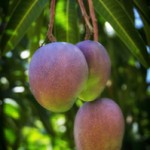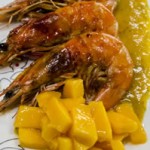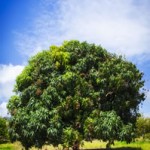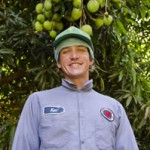Mango Season: The Best Of All
Ono Organics is a 10.6-acre certified organic farm in Moloa’a. Currently, the garden fills .07 acres, but soon will fill 2.3 acres. There are 70 species of fruit on the property, including 96 soursop trees.
Owner Ken Lindsey also teaches the Sustainable Gardening and Farming Program and Entrepreneurship in the Food Industry at Kaua’i Community College.
What’s growing now: Apple bananas, breadfruit, arugula, avocados, basil, beets, broccoli, cabbage (red and green), carrots, cauliflower, cherry tomatoes (from third-generation seeds), chikku, cilantro, coconut, egg fruit, eggplant, green beans, guava, kale, lettuce, lychee, mamey sapote, mango (Haden and Rapoza), pomegranate, rapini (broccoli rabé), scallions, soursop, tomatillo.
MANGO
The mango may be one of the world’s favorite tropical fruits. We sing love songs to mangos, paint them on canvas and write poetry about orbed fruit. There’s even an I Love Mangos Facebook page. A good mango can stop your world, and you’ll think of nothing else as you slip succulent slices of the juicy flesh into your mouth.
More than 500 varieties of manako, or mango, grow in Hawaii. Untreated fresh mangos are not permitted on the U.S. Mainland, in Japan and other countries because of quarantine restrictions.
Named after Capt. John J. Haden in 1910, the Haden mango originated in Florida from a Mulgoba seedling from India. The fruit is mild in flavor with a small amount of fiber.
Rapoza is a high-quality cultivar developed by the Department of Horticulture (DOH) at the University of Manoa. It was named after Herbert Rapoza, an employee at the DOH’s Poamoho Experiment Farm. In 1985, the Rapoza was selected from an open-pollinated Irwin seedling grown at the farm.
Season: Flowering begins in December to April, and matures three to five months later. Depending on variety, mangos can be available year-round. Haden and Rapoza mangos come on in late April, peak in July and August, and start to fade in September.
What to look for: Immature fruits are green with a purple blush. Mature fruits are yellow with a red over-color. Mangos should be picked before they are fully ripe, at which time they soften and fall. The fruit bruises easily and must be handled carefully to avoid damage.
Storage: Ripen mangos at room temperature and then refrigerate. Mature mangos keep fairly well under refrigeration for two to three weeks.
Preparation: The best way to enjoy a mango is ripe and ice-cold. To cut, hold mango stem side up, lengthwise. There is a wide, flat seed which runs parallel to the length. You want to cut on both flat sides of the seed. Cut through mango, a quarter inch from the right of the stem. If you meet resistance, it’s the seed. Move out a little more. Repeat on left. Remove the skin from the seed section, and make cuts across the edge, every half inch. Run the knife around the circumference, and drop cubes into a bowl. Make cross-hash cuts in the two halves, and spoon cubes into a bowl. Be careful
because these buggahs are slippery!
Mangos can be slipped into appetizers, soups, salads, entrees and desserts. You can use them to make a thick curd, luscious pie, snack bread, ice cream, sorbet, juice, dressing, salsa, jam, jelly, preserves, pickles, relish or chutney. Some people enjoy pickled green mango, or green mango with shoyu and vinegar.
Tip: Mango peel and sap contain urushiol, the same chemical found in poison ivy and poison sumac, which causes contact dermatitis in susceptible people. There are two kinds of contact dermatitis: irritant or allergic. The skin becomes red, sore, itchy or inflamed after direct contact. Wash the area right away and apply emollients, or moisturizers. It should clear up in two or three weeks. Call you doctor if symptoms are severe.
Health benefits: One cup of ripe mango contains 107 calories, zero fat, 3 mg. of sodium, 24 grams of sugar, and 1 gram of protein. It also contains 76 percent of the daily recommendation of vitamin C, 25 percent of vitamin A, 61 mg. of Omega-3 fatty acids and 23 mg. Omega-6.
Ono Organics can be found at: Farmers Market: Namahana Farmers Market in Kilauea (Monday 4 p.m. to dusk and Saturday 9 a.m. to 1 p.m.); Kaua’i Community Market at Kaua’i Community College (Saturdays at 9:30 a.m.). Grocery: Hoku Foods Natural Market, Papaya’s Natural Foods, and pop-up restaurant Grown. For more information, call sales manager Brian Ceccacci at 634-5022.
MANGO SAUCE
This sauce is sweet, sour and spicy, and goes well on tofu, fish, chicken or seared Kaua’i shrimp. It’s so good I even thought about putting leftovers on my morning yogurt! Makes about 1 cup.
* 1 mango
* 1 teaspoon rice wine vinegar
* 1 lime
* 1/4 cup cilantro
* 1 garlic clove, minced
* 1 inch fresh ginger, minced
* 1 nioi (Hawaiian chili pepper), minced
* salt
* pepper
Cut the mango as described above, and drop cubes into a blender.
Add the rest of the ingredients and puree.
Spoon 2 tablespoons of the sauce on a plate with your favorite protein.
- Brian Ceccacci with a couple of ripe Haden mangoes
- Unripe Rapozas
- Kauai Shrimp with Mango Sauce. Daniel Lane photos
- Mango trees grow up to 130 feet tall.
- Ken Lindsey under a mango tree. Daniel Lane photos








